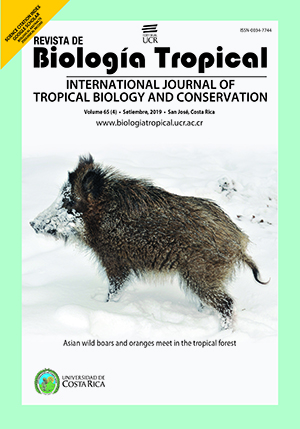Abstract
Abstract. Demersal fish from the R.V. Skimmer and R.V. Victor Hensen, Gulf of Nicoya, Pacific, Costa Rica: an update. Introduction: Since the middle of the XXth century the Gulf of Nicoya estuary (10o N – 85o W) has been the main source of numerous fishing resources, such as mollusks, crustaceans, and fish. The estuary is presently under the increasing inpact of local, regional, and global stressors. The expeditions aboard the Skimmer (1979-1980) and Victor Hensen (1993-1994) research vessels provided multidisciplinary data on the estuary in support of management policies. However, updated information is presently needed. Objetives: To update the published lists of fish species from both expeditions and make suggestions for new research areas in future evaluations of the ecosystem. Methods: The fish collections by the R.V. Skimmer covered a depth range of 10 to 50 m using an otter trawl net, and those aboard the R.V. Victor Hensen were made between 10 to 240 m depth using otter and beam trawl nets. The identification of the fish species and the measurement of its lenghts were made on board for both vessels. The species names were updated based on recent literature and the web page World Register of Marine Species (WORMS). The list of species identified in recent years based on voucher specimens from the estuary and deposited in the Ichthyology Collection of the Museum of Zoology, University of Costa Rica, was also included. Results: The total number of identified species from both vessels is 275, of which 13 are cartilaginous fish and 262 are bony fish. Seventeen species were identified after the pulication of the original lists, and Gymnothorax phalarus was described from the V. Hensen material. The species present in more than 50% of the 20 Skimmer stations, were: Prionotus horrens (16), Sphoeroides trichocephalus (14), Syacium ovale (13) and Synodus scituliceps (13). In the 12 stations of the V. Hensen study there were: Porichthys margaritatus (9), S. scituliceps (8), Bollmannia chlamydes (6), Symphurus callopterus (6) and S. evermanni (6). The five longest specimens collected by both vessels, were: the longtail sting ray Hypanus longus (117 cm), the pike conger Cynoponticus coniceps (103 cm), the brown sea catfish Sciades dowii (87 cm), the electric ray Narcine brancroftii (80 cm), and the queen corvina Cynoscion albus (75 cm). The average total length for 137 species measured during the Skimmer cruises was 26 cm, and 29 cm for the 164 measured during the V. Hensen cruises. Conclusions: In view of the increasing number of users of the estuarine resources, it is urgent a new multidisciplinary evaluation of the ecosystem in support of new management policies. The expected results may facilitate updating the Gulf of Nicoya Trophic Model, a management tool available for the estuary since 1998, and based mainly on information gathered during both expeditions. Ecosystem stressors, such as the extraction of resources, the input of pollutants and its possible link to endocrine disruption, and the presence of natural barriers such as hypoxia at deeper waters at the mouth of the estuary must be taken into account in a future evaluation.
##plugins.facebook.comentarios##

This work is licensed under a Creative Commons Attribution 4.0 International License.
Copyright (c) 2019 Recepción RBT; Jose Vargas Zamora


